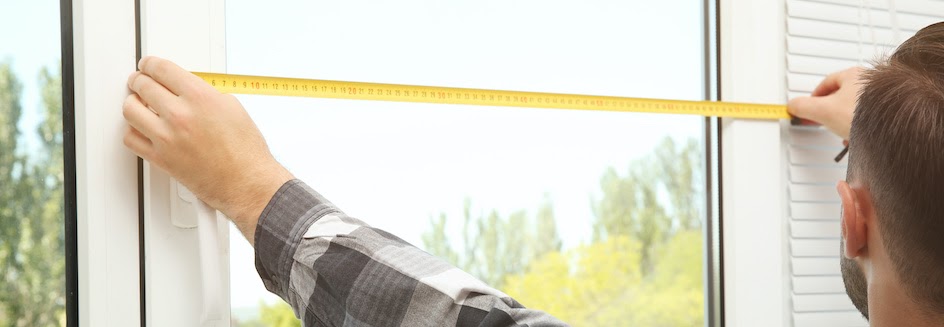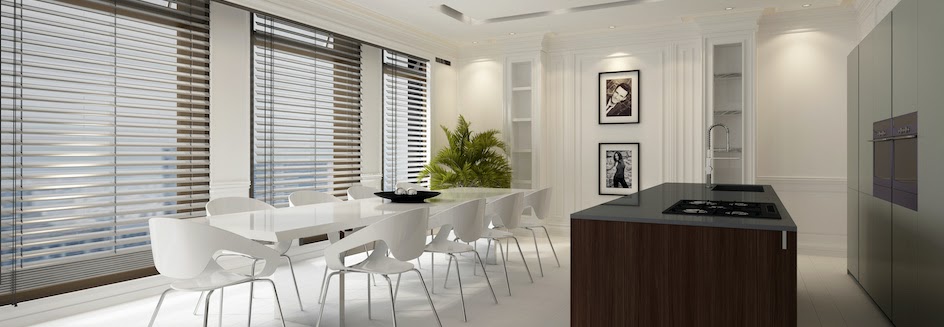Before you can order that set of made-to-measure blinds you've been eyeing, you need to, well, measure. And since your blinds will be cut down to size, you need to know how to measure for blinds so you can get a perfect fit.
You can't return made-to-measure blinds after they're cut, which means, if you get your measurements wrong, you'll be footing the bill for a second set of blinds. (Cue dramatic music.)
We're here to ensure that your measurements don't turn into a drama — or even a comedy. In fact, with this measuring guide, getting the exact measurements for your blinds will be so uneventful you won't even get a story out of it. But you will get perfectly fitted window blinds.
These measuring instructions go way beyond the old "measure twice, cut once" adage. (But seriously, do measure twice.) Here are the tools you need to gather, the decisions you need to make and the measurements you need to take before you order your new blinds.
Gather Your Tools
Measuring for new window blinds is so simple you probably have all the tools you need. There are just three of them:
— A pencil: Not a pen. Pencils are erasable, so it's always best to choose pencils over pens for home improvement projects. Depending on how you decide to hang your blinds (more on that below), you may need to make a couple marks on the wall as you measure.
— A piece of paper: You'll use this to write down your measurements or make doodles of your window. (Doodling is optional but adorable.) As you write your measurements, make sure to clearly notate which is the width measurement and which is the drop.
— A metal tape measure: In case you're considering grabbing that soft measuring tape from your sewing kit, let us persuade you otherwise. A metal tape measure is rigid so it won't flop about as you measure. It will be easier to hold it level so you can find the exact size of your window.
If you want to be extra careful, you can add a level to your tool kit to ensure that you are measuring straight across your window frame. In general, you can eyeball your tape measure to determine if it's level. But, if you're worried about taking crooked measurements, or if you live in a charming old house with slightly crooked window frames, a level can help ease your mind. Some metal tape measures even come with a built-in level to make your measurements more precise.
Decide How You'll Fit Your Blinds
Regardless of which blind type you choose — venetian blinds, wooden blinds, roller blinds, vertical blinds, roman blinds or day & night blinds — you'll have two ways to fit them: inside or outside the window recess. We'll go over the benefits of these two techniques so you can decide which is right for you, then find the matching measuring guide below.
Perfect Fit blinds are a little different, so we'll also cover how those fit in your window frame.
Inside the Window Recess
When you install your blinds inside the window recess, it provides a seamless look. The window blinds fit inside your window opening with either edge of the blinds meeting the sides of your window frame. The headrail (the top part of the blinds that houses the control mechanisms) installs into the top of the recess. The bottom of your blinds sits flush against the window sill.
Once they're installed, blinds that fit inside the window recess will appear flush with the surrounding wall — they won't protrude past the wall. Because of this seamless appearance, installing window blinds inside the recess is a popular choice, but it does have a downside: It offers less light control than installing blinds outside the recess.
Light can creep in between the edge of your blinds and the sides of your window frame with this installation technique — even if you've chosen blackout blinds. You can get around this by adding light blocking strips around the edge of your window or by mounting your blinds outside the window recess.
Outside the Window Recess
To mount your blinds outside the window recess, you'll hang them on your wall, above the top of the window. The blinds will protrude past the edge of the window, covering several centimetres of wall above, below and to the left and right of your window opening.
Unlike an inside mount, this mounting technique doesn't sit flush with your wall or offer the same seamless appearance. But it does provide the best light blocking, helping you make the most of your blackout blinds.
Because mounting your blinds outside your window recess will take up wall space, you'll need to make sure there's no furniture in the way of your window. If your furniture overlaps with your outside mount blinds, they won't hang properly.
Perfect Fit Blinds
Perfect Fit blinds attach to the window frame itself, just around the window pane. They work well with french doors or windows that tilt to open. This style sits flush against the window pane and provides complete room darkening with blackout blinds. These blinds move with your windows and doors, so when you open and close your windows, you won't have blinds banging around or dangling about.
Perfect Fit blinds are designed for UPVC window frames. So, unfortunately, if you have wooden window frames, these blinds won't be the perfect fit for you. Your windows also need to have a curved or diagonal inclined frame to allow for Perfect Fit window blinds. They won't work with square-framed windows.
If you have UPVC windows with a curved or diagonal frame, there are still some additional measurements you'll need to take to decide if these blinds will fit your windows. Carry on to our measuring instructions to learn more.
How To Measure for Blinds
Now that you've decided how you'll mount your blinds, you're ready to start measuring. Find the section that corresponds with your mounting preference or skip ahead to the section on Perfect Fit blinds to learn how to measure for this specialty option.
Measuring for Blinds That Fit Inside the Window Recess
If you're going to mount your blinds inside the window recess, you need to find the recess size. Start by measuring the recess width.
Measure the width of your window in three places: across the top of the recess, across the centre of the recess and across the bottom of the recess. Write down all three measurements.
If any architectural features protrude into your window recess (for example, there might be a chair rail or a bit of tile that wraps around the edge of the window frame), you should also measure the width of your window recess at that spot. Write this measurement down with the other three.
Now, circle the smallest measurement. That is your window's narrowest part, and it's the measurement you'll use as the overall width of your window.
Next measure your window's drop (the length from top to bottom). You'll measure inside the recess in three places: down the left-hand side of the recess, down the centre of the recess and down the right-hand side of the recess. Write down all three numbers and circle the shortest measurement. This is what you'll use for your window's drop.
When you order blinds based on your window's recess size, the width of the blinds you receive will be slightly smaller than the measurements you provide.
For venetian blinds, you'll notice that the slats are slightly smaller. For roller blinds or roman blinds, the fabric width will be slightly smaller. And for vertical blinds, the length will be slightly smaller. This is to prevent the edge of your blinds from getting stuck against the window frame (or the window sill in the case of vertical blinds) when you open and close them.
The experts will make these adjustments, so you only need to provide the exact measurements of your window recess.
Measuring for Blinds That Fit Outside the Window Recess
When you order blinds to mount outside the window recess, you'll select "exact blind size" at checkout. The blinds you receive will be the full width that you provide, so you need to make sure that your measurements are exactly what you want. We recommend overlapping the wall by at least 35mm on each side of your window frame to ensure that your window is fully covered by your blinds.
To begin your measurements, decide how far you want your blinds to go past your window on each side. If you decide to go with the minimum recommendation of 35mm, measure 35mm out from the left side of the window, and mark the wall with your pencil. Then measure 35mm out from the right side of the window, and mark the wall. To make sure that you're measuring straight across the window, use a level or use the top or bottom of the window as your guide when you make your marks.
Measure from one pencil mark to the other, and you'll have the width of the blinds.
Now measure from top to bottom. Decide where you want to install the headrail of your blinds and mark this spot with a pencil. Then decide where you want the bottom of your blinds to hit and mark this spot with a pencil. Again, you can use a level or use the left or right of the window frame to make sure you're measuring straight down from top to bottom.
Measure the distance from your top pencil mark to your bottom pencil mark, and you have the drop of your blinds.
Measuring for Perfect Fit Window Blinds
Before you can measure for Perfect Fit blinds, you need to take a few extra measurements to ensure that these blinds will work with your windows. To install Perfect Fit blinds, you need a 25mm clearance all the way around your window frame. Measure in several places around your window to make sure there's 25mm of frame between the window pane and any vents, window handles or walls.
You also need 10mm of beading depth to install the brackets for Perfect Fit blinds. The beading on your UPVC window is the small strip of plastic that attaches the window pane to the window frame. There is generally a layer of rubber between the metal beading and the glass.
Check your beading depth by sliding a knife between your window pane and the rubber. Make a mark on the knife and measure the distance from the mark to the tip of the knife — this is your beading depth, and if it's more than 10mm, you can proceed to measuring for your blinds.
For Perfect Fit blinds, you're only measuring the width and drop of your window pane — not your entire window frame. You'll only measure across the visible glass. Measure the width of your window pane in three places: across the top, across the centre and across the bottom. Circle the smallest measurement, and use that for your width.
Now measure the drop of your window pane in three places: down the left-hand side, down the centre and down the right-hand side. Circle the shortest measurement, and use that for your drop.
That's it! You have the numbers you need to order new blinds.



